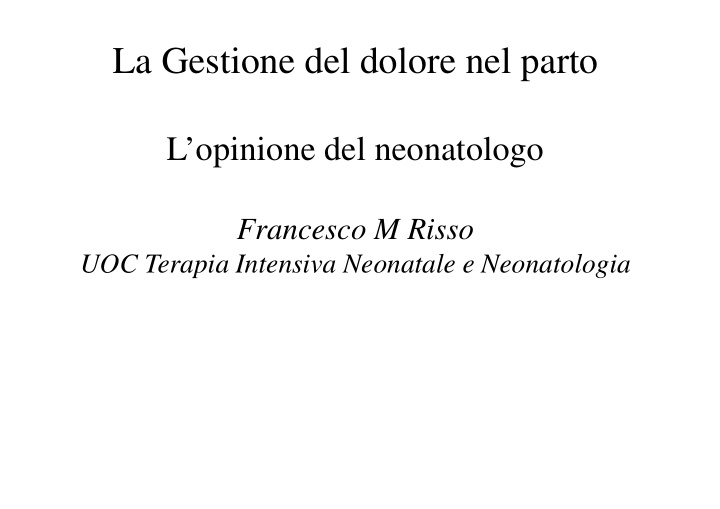



La Gestione del dolore nel parto L’opinione del neonatologo Francesco M Risso UOC Terapia Intensiva Neonatale e Neonatologia
BREASTFEEDING is an important public health concern Short-term maternal benefits of breastfeeding include Decreased postpartum blood loss and more rapid involution of the uterus. Long-term maternal benefits include Decreased incidence of type 2 diabetes mellitus Decreased incidence of breast and ovarian cancer. Early cessation of breastfeeding or no breastfeeding is associated with Increased risk of maternal postpartum depression The duration of breastfeeding is positively associated with a decreased risk of maternal hypertension and cardiovascular disease. Benefits for the child include Decreased risk of acute otitis media, necrotizing enterocolitis,nonspecific gastroenteritis, severe lower respiratory tract infection, atopic dermatitis, asthma, obesity, diabetes (types 1 and 2), childhood leukemia, and sudden infant death syndrome. The American Academy of Family Physicians recommends that infants be breastfed for the first year of life, and that they be breastfed exclusively for the first six months of life
Differenti categorie di ricerca
cosa come regole trasparenza comunicazione La perdita di tempo sulla ricerca di fattori eziologici della SIDS senza tener conto di notizie già note probabilmente avrebbe riconosciuto il rischio di dormire proni qualche decade prima evitando cosi migliaia di morti Moher D Lancet 2016
36 % Problemi al neonato Percezione Spinte 56 % Allatamento 8 %
As medical practitioners, it is important to ensure our anesthetic interventions do not impede the mother’s or infant’s ability to breastfeed Among motivated parous women with a previous history of successful breastfeeding, epidural analgesia maintained with an analgesia solution that contains fentanyl did not have adverse effects on breastfeeding outcomes
Up to 37% of women experience moderate or severe pain after vaginal delivery (East, Midwifery, 2012) After pains are further exacerbated by breastfeeding, as nipple stimulation causes the release of oxytocin, which promotes additional and more forceful uterine contractions (Takahata et al. Plos One, 2018) Severe compared with mild pain during the first 36 hr after delivery was associated with a 3-fold increase in the incidence of postpartum depression at 8 weeks postpartum (Eisenach et al., Pain 2008)
PCEA (patient controlled epidural analgesia ) for sever after pains The greatest disadvantage of PCEA is that the epidural catheter needs to be maintained in situ, and the patient is connected to an electronic pump The risk of using PCEA is extremely low. Infection, for example, is essentially a nonissue if the catheter is maintained in situ for 4 days or fewer
PCEA was unequivocally helpful to enable early initiation of breastfeeding. Because PCEA provides complete pain relief without sedation, it should be considered as an option to encourage women with a history of severe after pains to initiate breastfeeding soon after delivery .
Recommend
More recommend